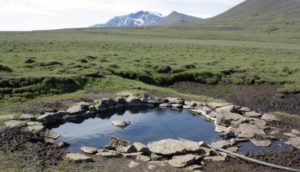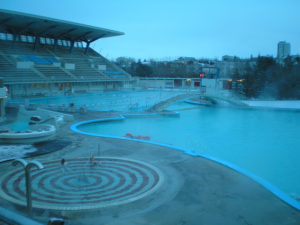 Because Iceland is, in fact, a volcanic island that has risen from the seabed, the water deep underground is hot from the energy of the Earth. Icelanders use that water to heat their homes and generate electricity, but a side benefit is that thermal swimming pools are just about everywhere. There were three in downtown Rekjavik, many that can be found out in the countryside along the roads (careful, they can be really hot) where you can jump in for a dip even though the ambient air temperature might be in the 30s (Fahrenheit). Of course, there is also the well advertised and touristy Blue Lagoon that for an astronomical fee (about €40 or the equivalent of about $43 USD per person), they will bus you there and allow you to experience the heat of the Earth all while lightening your wallet. The water comes from about 6500 feet underground and, of course, is loaded with minerals.
Because Iceland is, in fact, a volcanic island that has risen from the seabed, the water deep underground is hot from the energy of the Earth. Icelanders use that water to heat their homes and generate electricity, but a side benefit is that thermal swimming pools are just about everywhere. There were three in downtown Rekjavik, many that can be found out in the countryside along the roads (careful, they can be really hot) where you can jump in for a dip even though the ambient air temperature might be in the 30s (Fahrenheit). Of course, there is also the well advertised and touristy Blue Lagoon that for an astronomical fee (about €40 or the equivalent of about $43 USD per person), they will bus you there and allow you to experience the heat of the Earth all while lightening your wallet. The water comes from about 6500 feet underground and, of course, is loaded with minerals.

We chose to walk a few blocks from our hotel to the public Laugardalslaug Thermal Pool and for only about $9 USD soak up the geothermal heat. It was marvelous. The outdoor temperature was almost 40 degrees Fahrenheit (a little more than 4 degrees Celsius) but once you were in the water, it was wonderful. The sign posted by the pool indicated the water temperature was 38 degrees Celsius, about 100 degrees Fahrenheit.
While we soaked in one of the smaller sections of the pool complex, we met two young ladies from Germany who were visiting Iceland, amazingly a young man from Lancaster County, Pennsylvania where we lived for 30+ years, and a gentleman from Italy who has lived in Iceland for about 15 years. He told use what we suspected all along when he said, “The Northern Lights tour packages are a marketing ploy to get people to Iceland. Good luck seeing them!”
We were undaunted in our attempts to see the Northern Lights but, as you read earlier, unsuccessful. As unnatural as it seems to swim outside in the Icelandic cold, it felt wonderful. Chatting with folks in the pool from around only added to the enjoyment.
Winter swim anyone ?

